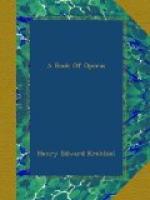The next five scenes in Berlioz’s score are connected by M. Gunsbourg and forced to act in sequence for the sake of the stage set, in which a picture of Marguerite’s chamber is presented in the conventional fashion made necessary by the exigency of showing an exterior and interior at the same time, as in the last act of “Rigoletto.” For a reason at which I cannot even guess, M. Gunsbourg goes farther and transforms the chamber of Marguerite into a sort of semi-enclosed arbor, and places a lantern in her hand instead of the lamp, so that she may enter in safety from the street. In this street there walk soldiers, followed by students, singing their songs. Through them Faust finds his way and into the trellised enclosure. The strains of the songs are heard at the last blended in a single harmony. Marguerite enters through the street with her lantern and sings the romance of the King of Thule, which Berlioz calls a Chanson Gothique, one of the most original of his creations and, like the song in the next scene, “L’amour l’ardente flamme,” which takes the place of Goethe’s “Meine Ruh’ ist hin,” is steeped in a mood of mystical tenderness quite beyond description. Mephistophetes summons will-o’-the-wisps to aid in the bewilderment of the troubled mind of Marguerite. Here realism sadly disturbs the scene as Berlioz asks that the fancy shall create it. The customary dancing lights of the stage are supplemented with electrical effects which are beautiful, if not new. They do not mar if they do not help the grotesque minuet. But when M. Gunsbourg materializes the ghostly flames and presents them as a mob of hopping figures, he throws douches of cold water on the imagination of the listeners. Later he spoils enjoyment of the music utterly by making it the accompaniment of some utterly irrelevant pantomime by Marguerite, who goes into the street and is seen writhing between the conflicting emotions of love and duty, symbolized by a vision of Faust and the glowing of a cross on the facade of a church. To learn the meaning of this, one must go to the libretto, where he may read that it is all a dream dreamed by Marguerite after she had fallen asleep in her arm-chair. But we see her awake, not asleep, and it is all foolish and disturbing stuff put in to fill time and connect two of Berlioz’s scenes. Marguerite returns to the room which she had left only in her dream, Faust discovers himself, and there follows the inevitable love-duet which Mephistophetes changes into a trio when he enters to urge Faust to depart. Meanwhile,




